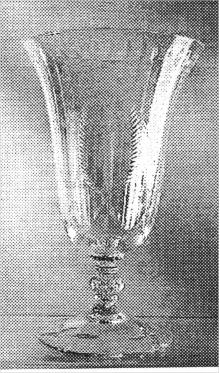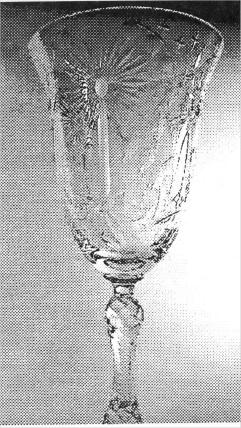National Cambridge Collectors, Inc.
A non-profit 501(c)(3) organization.

The Candlelight Engravings
by Gary Payne
Issue #377 - September 2004
I would like to tell a deeply human story about the Cambridge Rock Crystal Candlelight engravings, and how family love inspired a major change in its design. The Candlelight line of engraved glass was cut by hand from the mid thirties to the late fifties, and little is known about its two distinctly different and beautiful engravings. Indeed, in NCC's new Rock Crystal Engravings Book, only one candlelight engraving (the 897) is depicted. The other missing engraving is simple in its design, yet it is striking and bold in its appearance. Written documentation about this design has not yet been found. Why would Cambridge produce two Candlelight engravings?
Herschel Hancock led the engraving department for The Cambridge Glass Company; Herschel and his employees served Cambridge Glass as independent subcontractors, who would buy Cambridge blanks, apply their magic of cutting and polishing, and sell the finished pieces back to Cambridge. His group of engravers and polishers began with only a few artisans, and the little department grew to more than forty employees during the 1940s.
While much of their work focused on Cambridge's many rock crystal engravings including the popular and widely distributed lines of Adonis, Achilles, and Croesus, the Candlelight engravings remained available throughout the Cambridge years, though in limited quantities. While the Candlelight cuttings were not Cambridge Glass' most popular engravings, Candlelight was destined to hold a special significance and challenge for Mr. Hancock and his family.
I should diverge from this story to point out that all the Cambridge engravings were done by hand without the benefit of an established pattern or guide. Mr. Hancock, who was clearly a creative genius, would begin the process by creating and cutting an original design on a blank crystal; following this creative work another artisan would paint Hancock's original engraved design onto other blanks including vases, serving pieces, accessories, etc. (white ink or wax was used in the painting because they appear most distinctly on crystal) With a painted blank placed in front of them as their guide, in worker Sidney Garrett's own words, "We (the engravers) would transfer the painted design from what our eyes saw to what our hands on the wheel would cut!" Yet, on close examination of the engravings on different blanks, Cambridge cuttings appear identical as though some precise pattern or matt was used. As we examine these engraved pieces, what we see is the fine work of skilled, accomplished artisans as they cut meticulously each stem, serving piece, vase, or accessory.
Obviously, each piece of glass required considerable time for cutting and polishing; these engraved pieces were more expensive to make, and the precise handwork resulted in fewer pieces being available to the public. Cambridge glass was known as a standard for fine quality glass, and Hancock's group certainly maintained and even raised that high standard of excellence with the artisans in the cutting and polishing department.
An enlarged photograph of Hancock, inspecting one of his creations, hangs prominently in our NCC Museum. Look for it the next time you are there.
The Original Candlelight Engraving
 With regard to the Candlelight engravings (although this has not
been documented), I believe that Mr. Hancock first created a
Candlelight engraving that I call, "The Candlelight Arrow Engraving.2"
This is simply the name that I use to identify this engraving. Since no
written record apparently exists of the design, it does not have a
reference number, but I believe it was the first of the candlelight
engravings.
With regard to the Candlelight engravings (although this has not
been documented), I believe that Mr. Hancock first created a
Candlelight engraving that I call, "The Candlelight Arrow Engraving.2"
This is simply the name that I use to identify this engraving. Since no
written record apparently exists of the design, it does not have a
reference number, but I believe it was the first of the candlelight
engravings.
The engraving consists of a series of vertical cut lines each topped with a point that resembles an arrow. This arrow design was somewhat similar to some other unnamed but identified Cambridge cuttings such as 4072, 4074, 4075, and 998, which was identified as "Wedding Rose.3" However with the Candlelight engraving, the arrow lines are interrupted with distinctly cut candles (that appear gray since they were not polished) usually sitting on a ribbon bow or flower. These small cut candles are surrounded by sharp lines depicting rays emanating from the candles. The bottoms of the stems were also cut on the underside. The stems on these pieces are usually the early 3114 or 3100 stems, and serving pieces, vases, and other accessories were also made. I believe the entire engraving has an art deco-look reflecting the time of the cutting.
This Candlelight "Arrow" Engraving is beautiful and distinct, but its simplicity makes each cut candle almost jump out from the pattern. Of course, since no record has been found of this engraving, a record of the blanks on which this engraving was cut has also not been found. This cutting was probably made for only a few years, and collectors who find one of these early pieces are quite fortunate.
Inspiration for A New Engraving
During this period of time when the first Candlelight engravings were being produced, our story takes a surprise turn. A second - and sub-stantially different - candlelight engraving suddenly emerged! I can find no other case in the history of Cambridge Glass that such a major revision to an engraving occurred. We know that this revision to the original Candlelight engraving took place in honor of a wedding in Mr. Hancock's family. We know that Mr. Hancock's daughter and his granddaughter both received wedding gifts of Cambridge Candlelight engraved glass. We also know that, in addition to members of the Hancock family, engraved Candlelight was also a wedding gift for Marjorie Bennett Orme, wife of the Cambridge Glass Company's vice-president and eventual president. As Hancock worked on this revision to the existing candlelight engraving, the "revision" eventually became a completely new design unlike the first candlelight engraving in every respect!
 Emerging in this entirely new design was a stunning, highly complex
engraving that could be described as similar to a "lily of the valley"
pattern with flowing vines and hanging flowers. These vines are
interrupted by very large candles sitting on a tied bow, and small
crosses and flowers help to engrave almost every inch of each piece.
The numerous cut lines in this engraving literally grab the light and
reflect it outward. The cut candles tend to appear larger than those in
the "Arrow" Engraving and their appearance is dramatic. While the
previous Candlelight "Arrow" Design was marked by its simplicity, this
newer engraving is distinguished by its complexity.
Emerging in this entirely new design was a stunning, highly complex
engraving that could be described as similar to a "lily of the valley"
pattern with flowing vines and hanging flowers. These vines are
interrupted by very large candles sitting on a tied bow, and small
crosses and flowers help to engrave almost every inch of each piece.
The numerous cut lines in this engraving literally grab the light and
reflect it outward. The cut candles tend to appear larger than those in
the "Arrow" Engraving and their appearance is dramatic. While the
previous Candlelight "Arrow" Design was marked by its simplicity, this
newer engraving is distinguished by its complexity.
Identified by the Cambridge Glass Company simply as engraving, "897 Candlelight," one cannot help but sense the deep love that helped Hancock to create this beautiful engraving. The 3116 (knife rest) stem is usually found with this cutting. When held in front of a light, this engraving actually sparkles. It has been rumored that among the wedding gifts in the Hancock family were a large chandelier, a punch bowl, dolphin hurricane lamps, and many pieces of a dinner service all cut for the first time with this 897 Candlelight engraving. NCC's new engravings book, "The Listings," (edited by Mark Nye) contains a complete listing of all the blanks that were made available to the public with this cutting; again, these are identified as "897 Candlelight." Finding any Cambridge engraving is difficult. Finding one of the Candlelight engravings is an even greater challenge, but it is well worth the effort. Whether you find the Candlelight Arrow Engraving or the 897 Candlelight Engraving you will feel rewarded when you hold it up to the light and remember the story of Herschel Hancock, a master artisan, who wanted to create something exceptional as a wedding gift. Members of the Hancock family continue to enjoy their collection of engraved Cambridge Candlelight glass today.
ENDNOTES
- I am deeply indebted to Lynn Welker for his memories and assistance that helped to fill some knowledge gaps. Also my thanks to Sidney Garrett, who was an artisan in the Engraving Department, for the personal information provided to supplement the details in this article.
- The Candlelight Arrow Engraving is a name created by the author for identification purposes. At present, there isn't any written record of this engraving or the blanks to which this engraving was applied. However, the author's collection includes a number of pieces with this engraving.
- All of these engravings may be found in NCC's "Rock Crystal Engravings" book edited by Mark Nye. An accompanying book, "The Listings," also edited by Mark Nye, provides listings of the blanks to which the engravings were applied. Both books are available from NCC.